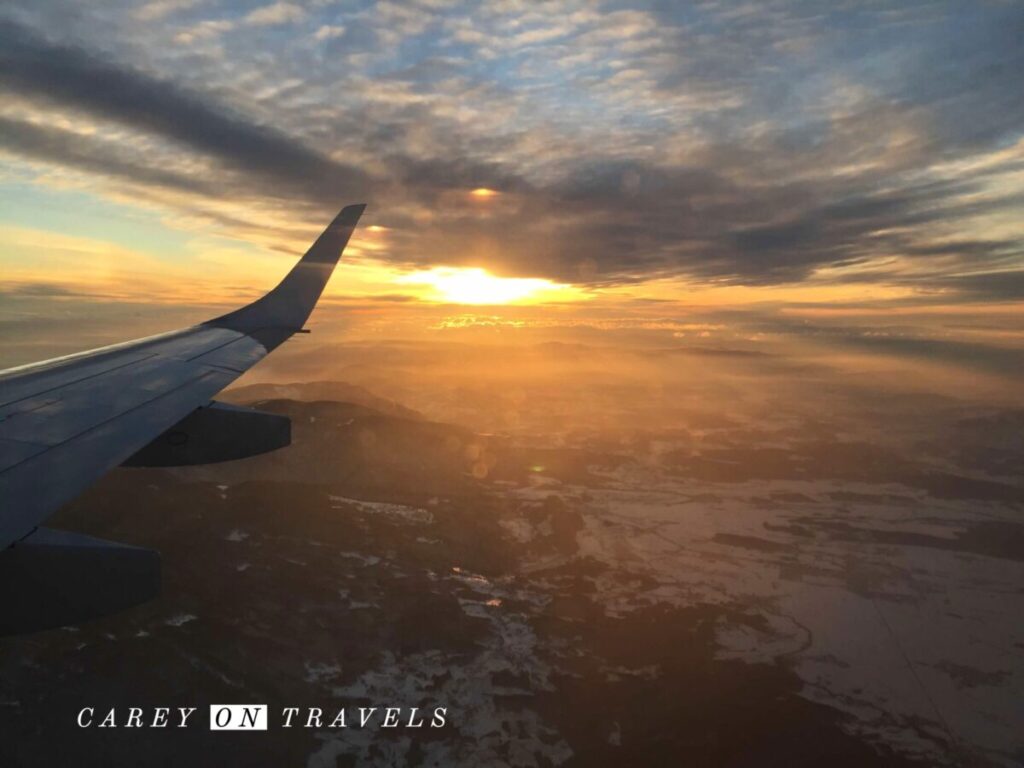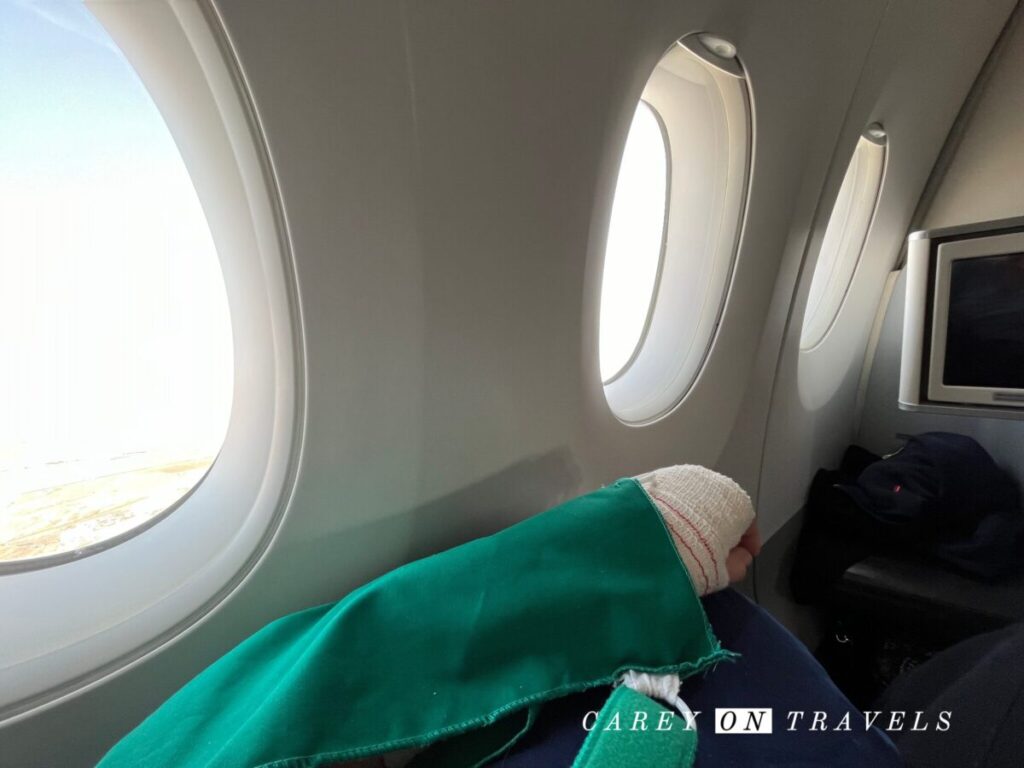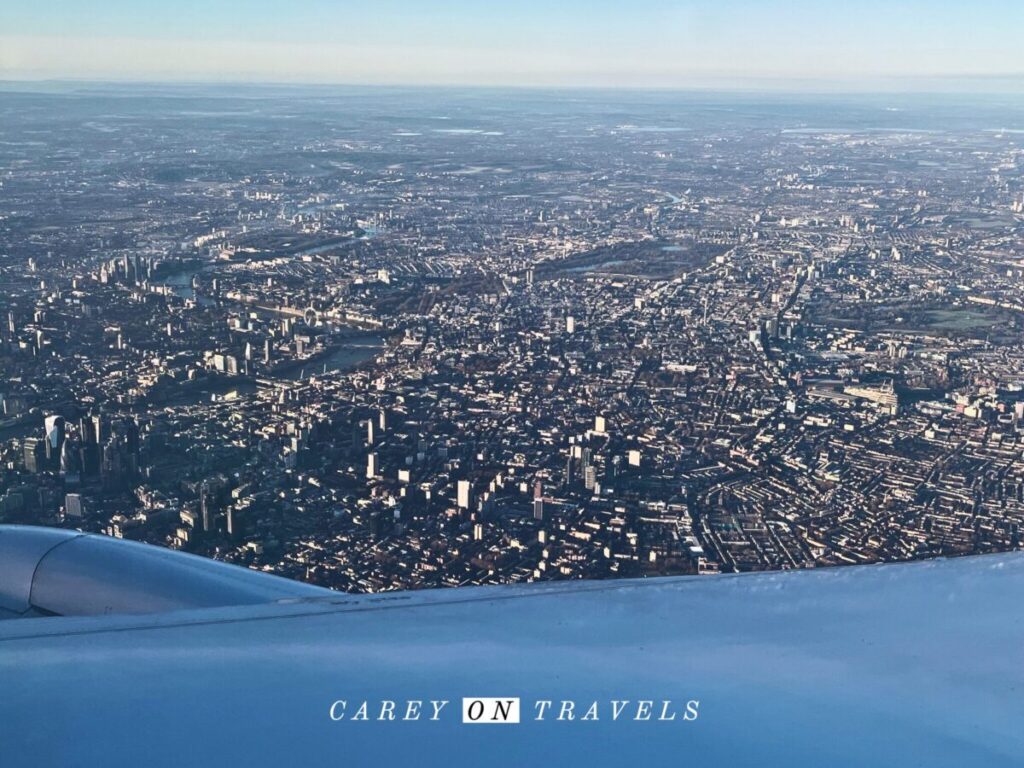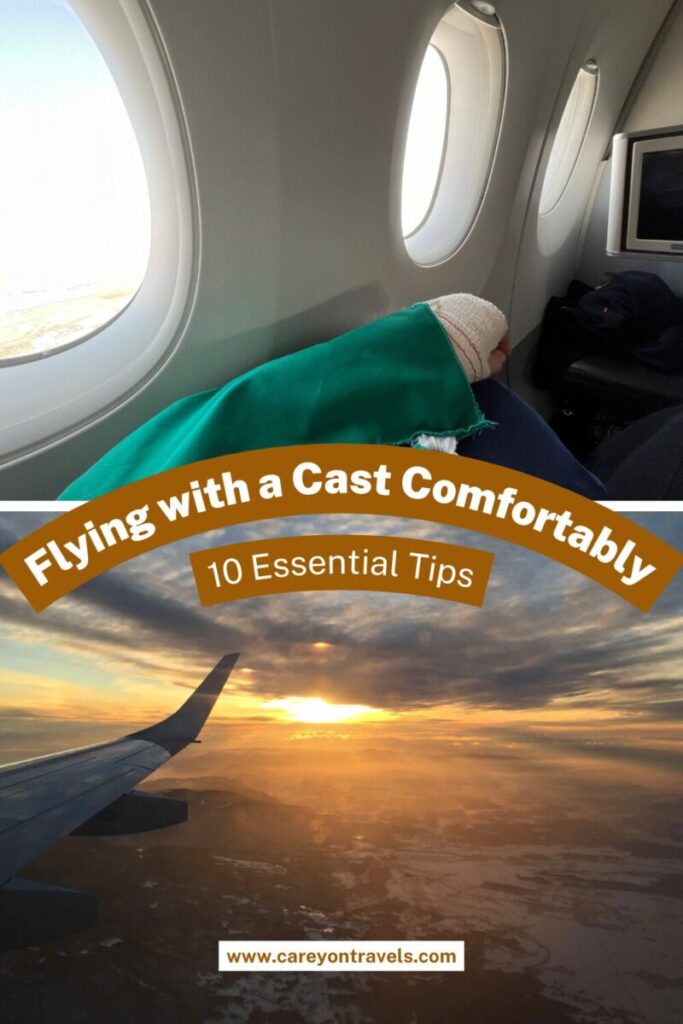Are you traveling by air soon, but you’re wearing a cast? While it might seem challenging, flying with a cast isn’t as daunting as it appears. With some forward planning and a bit of patience, you can ensure your journey is as comfortable as possible. Our tips are meant as a general reference only. Always consult with your medical provider and the airline prior to flying. Here are our essential tips to make flying with a cast more comfortable.
This post may contain affiliate links. If you make a purchase through these links, we will earn a small commission at no additional cost to you. We recommend products we have personally used or verified. Read the full disclosure here.
If you don’t have time to read this post now, pin it for later!

1. When Can You Go on a Plane With a Cast?
Rules differ by airline. The general rule of thumb (to be confirmed with your individual airline and your medical provider) is:
| Flight duration | When you can fly |
|---|---|
| 2 hours or less | After 24 hours in your cast |
| More than 2 hours | After 48 hours in your cast |
If you’ve had surgery, the timing will vary extensively. For surgery on a simple fracture, you may still be allowed to travel within 24-48 hours. Arm and wrist surgery typically will require 4-5 days before traveling. Time to travel after more complex surgeries will vary by type. And, always check with your medical provider and your airline to confirm their policy.
Why Are These Flight Restrictions in Place?
Everyone swells on planes. This is due to a combination of gravity and sitting for extended periods of time. When you are wearing a cast (whether made of plaster of Paris or fiberglass), your circulation can be restricted in the confines of the cast. DVT (deep vein thrombosis) or compression syndrome can result.
I have seen some recommendations that all casts be split for all flights, and that splints should be worn in place of casts wherever possible (even if you’re not within 2 days). Please check with your doctor on their recommendations.
What if You Need to Fly with a Cast Earlier?
If you need to fly earlier than the required waiting period, you may need to have your cast split. I recently broke my wrist while abroad, and had about 15 hours of flying time to get home. I flew home the day after getting a cast on. Though I probably should have waited a few days to travel, I decided to take those flights, because I wanted to have surgery done once I got home.
Because I was within the 2 day period for the cast, the doctor put my arm in a plaster splint rather than a normal cast. Even with the soft cast, which was wrapped very tightly, the pressure and pain during descents was a bit intense. Don’t forget also to get a fit-to-fly certificate (see #2).
2. Do You Need a Fit-to-Fly Certificate for a Cast?
Some airlines require a doctor’s note to fly in the form of a ‘fit-to-fly’ certificate, especially if your injury is recent. This is to ensure that flying won’t exacerbate your condition. It’s also a good idea to discuss potential complications, like swelling or pain, and how to manage them with your medical provider.
For our first flight, our airline checked my fit-to-fly, requiring a copy to be kept on file before I could travel. They asked a lot of questions as well. They also required that it be 2 days since the injury (which is had). We split our travel into 2 days to let me recover a bit between flights. On the second day after I got my cast on, the airline didn’t ask for this certificate. I assume this is coincidental.
3. Inform the Airline in Advance
Once your doctor gives you the green light, inform your airline about your condition. They can offer you special assistance, such as priority boarding, extra legroom seating, or wheelchair services. The more they know in advance, the better they can accommodate your needs.
This is one that I didn’t think of, and it certainly would have smoothed out our airport experience. For my first flight, I didn’t get any adjusted seating though they did send me through the security line for those needing extra assistance.

4. Can I Go Through Airport Security With a Cast?
Your cast may require additional screening at security checkpoints. Be ready to explain your situation to the security agents, and allow extra time for this process. If your cast is removable, they may ask you to remove the cast during the screenings.
A few specific tips regarding security:
- You should be sent through the line for those needing extra assistance. If not, ask for this when you reach security.
- Expect that they will do additional screening. This screening may include an inspection, a test of your hands, a hand-held metal detector screening, and a test for explosives. In Munich, I had this done twice. Make sure you leave enough time for these checks.
5. Choose Your Seat Wisely
Selecting your seat will depend on what type of cast you have on. If you have a below the knee cast or an upper body cast, you’ll normally be able to sit in a normal seat, though might like to have it elevated. If you can’t bend your knee, be sure to make arrangements with your airline in advance. Think through your individual situation before discussing seating with the airline.
If you are able to walk around, think about getting a seat where you can easily get up and walk around. This will help promote blood flow, reducing the risk of DVT. In my case, I opted for a seat where no one would bump into my arm for our shorter flight. For the 10 hour flight, I thankfully got an upgraded seat where I could lie down and elevate my arm for much of the flight.

6. Keep Swelling in Check
Elevation is key to reducing swelling. Try to keep your casted limb elevated during the flight. A few things you can consider using to elevate your cast are a carry-on bag, a pillow or blanket provided by the airline, or even a travel pillow or travel blanket for this purpose. Don’t be shy about asking the flight attendants for additional pillows in this situation.
TRAVEL HACK! Elevate an injured lower leg is the Airplane Travel Footrest Hammock. This is great for traveling any time, but particularly useful when traveling with a lower leg injury.
Check with your doctor about wearing compression socks or sleeves to assist in circulation, depending on where your injury is. Descents and landings definitely put a lot more pressure on the cast than at any other time of the flight.

7. Stay Hydrated and Move Around
Dehydration can worsen swelling, so drink plenty of water before and during your flight. Avoid alcoholic drinks, since they promote dehydration. I always carry an empty water bottle to fill up after security, along with my electrolytes. My favorites electrolytes are Nuun strawberry lemonade and Liquid IV.
While you should limit movement to avoid discomfort, it’s also crucial to follow any recommended exercises for your toes or fingers to promote blood flow. My doctors recommended moving my fingers around nearly constantly to keep some circulation going and the swelling in check. If it’s safe and feasible, take short walks up and down the aisle every few hours. If that’s not possible, do seated exercises to reduce the risk.

8. Pack Pain Relief and Other Essentials
Prepare a small bag with pain relief medication (as advised by your doctor), snacks, water, and any other essentials you might need during the flight. Having everything within arm’s reach will minimize the need to move around too much. If flying solo, ask the flight attendants or possibly your neighbor to help with accessing and opening these if you can’t due to your injury.
9. Listen to Your Body
Finally, and most importantly, listen to your body. If you experience significant discomfort or pain while flying with a cast, alert a flight attendant. They’re trained to assist with medical concerns and can help make your flight more comfortable. Keep in mind that DVT’s can form anytime within a month after traveling. If you notice extreme swelling or discomfort, consult with your doctor.
10. Travel Insurance
In the unpredictable world of travel, purchasing travel insurance can be a game-changer. Travel insurance can cover a range of unforeseen events, from trip cancellations and delays to medical emergencies and treatment costs abroad.
With a cast, you’re at a higher risk for complications, and having insurance means one less worry on your mind. We use Squaremouth for our travel insurance purchases, and encourage you to check them out. Selecting the right travel insurance for a pre-existing conditions (such as an existing injury) is critical, as not all insurance policies cover pre-existing conditions. They provides a variety of travel insurance options for you, with easy comparisons of features.
Look for policies that offer:
- Comprehensive medical coverage, including the possibility of medical repatriation;
- Pre-existing medical condition coverage if needed (many do not);
- Coverage for changes to your trip itinerary or trip cancellation should you require early return or additional accommodation due to your condition
Remember, peace of mind is priceless, and being prepared can make all the difference in handling unexpected situations smoothly. If you are planning a trip abroad even without an injury such as this, travel insurance is inexpensive and worth the small investment.
Conclusion
Flying with a cast certainly requires extra planning, but it doesn’t have to negatively impact your travel plans. With the right preparation and a positive mindset, you’ll reach your destination comfortably and safely. Remember, every traveler’s situation is unique. Consult with your doctor and the airline to tailor these tips to suit your needs and ensure a smooth journey ahead.
If you enjoyed this post, pin it for later!

Travel Resources
We recommend booking through our preferred travel booking sites below.
| Air Travel | SkyScanner |
| Lodging | Booking.com, VRBO.com, Expedia.com, Hostelworld |
| Tours and Activities | Viator.com, GetYourGuide.com, TakeWalks.com |
| Car rentals | Discovercars.com |
| Travel insurance | Squaremouth |
| Bike and scooter rentals | BikeBookings.com |
| Train tickets | Trainline, RailEurope |
| Bus tickets | Flixbus, Busbud |












I never thought about flying with a cast. I can see that if you get injured on holiday and need a cast, this could be a significant issue. Thanks for the tips.
Thanks, and hope you never have to use them
This is great advice if I ever find myself traveling in a cast. Knock on wood!
Thanks, hope you never need it.
These are great tips! I’ll admit I never really thought about having to travel wearing a cast, but this is helpful information to share. So many things to consider and you covered them all.
thanks
Fortunately, I have never had a cast, but my mother suffers from knee issues, so some of these tips are quite helpful.
Thanks, I hope you’ll never need a cast.
So sorry for the incident and it’s good you created this article for us because things happen and stopping our travels isn’t something we would want to miss if it’s possible. Love these tips
This is one of those things you hope never happens, but when it does, it needs to be managed.
I have fortunately never had to think about this problem, and *hopefully* never will but I can imagine flying with a cast is quite tricky! These are great tips in case I ever do find myself in this spot.
Thanks, and as you say, I hope you never need to use these.
Hallo, I am sorry you got injured and hope you make a speedy recovery! Definitely talk to your health provider when you can fly – with a well fitting cast, it is usually unproblematic. Also bear in mind that you are somewhat immobilised by a cast, especially on the leg, which means you may require regular low molecular weight heparin to prevent deep vein thrombosis. Usually health providers bring this up, sometimes they don’t… better to ask.
Thanks, good advice!
As someone who’s never had a cast, I never would’ve thought to do some of these things! What great tips.
Thanks, hope you never need one.
Hopefully I will never need to refer to this post! Fingers crossed!!
I hope you never need it.
great tips! not only when you have a cast!
thanks!
Flying with a cast sounds rough, and one of those things you don’t ever really plan for. These are great tips to keep in mind if it does
Thanks, hoping you never need to use them.
Wooww! I had never thought about having to fly with a cast before! I definitely learned something new today! Are you totally recovered from your surgery? I hope so!
Thanks, I got out of the cast last week.
Super helpful guide especially the tip about staying hydrated and to keep moving around!
thanks
Have been in before! If you can, the bulkhead has extra legroom and the least amount of walking.
I’ve done the bulkhead when I had a full leg injury, it definitely made a difference.
I am glad I found this; my sister is about to fly an intercontinental flight after breaking her collarbone! :/ Great info!
Thanks, hope she recovers quickly.
This is fascinating. I tore a knee ligament, and if I had to fly, your post would have been so helpful! The swelling in altitude is definitely something to think about in relation to a cast.
It’s one of those things you hope you’ll never need to know about; but handy to know it if you’re in a cast.
Aw man, I’ve always wondered about this – its been in the back of my mind ever since starting my travels abroad! Saving this for later just in case… 🙊
Thanks, hope you’ll never need it.
OMG! I can’t imagine how uncomfortable it is to fly with a cast. Hopefully I will never have to experience that, but now I have these helpful tips for how to do it!
I hope you won’t have to experience this either!